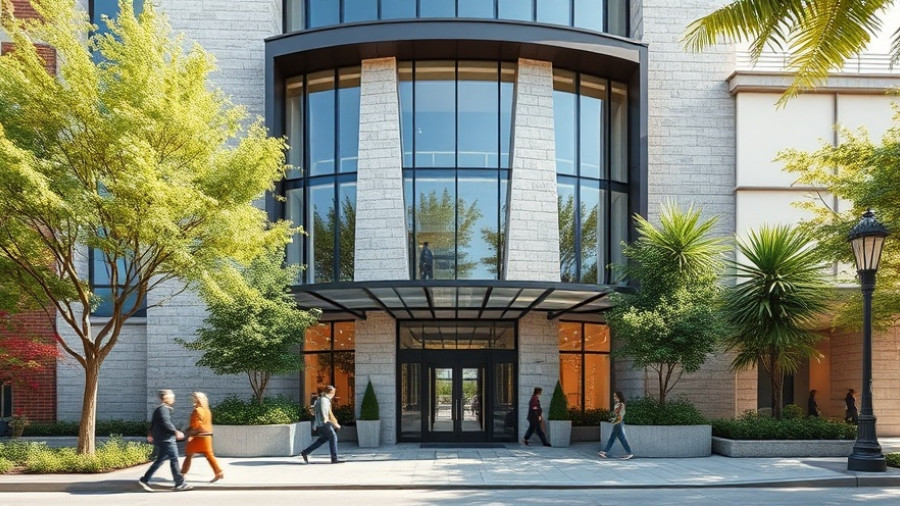
Investing in the Future of Construction Technology
In an exciting trend for the construction industry, six contech startups have recently secured a remarkable total of $208 million in funding. This surge in investment reflects the growing confidence in innovative technologies that promise to revolutionize construction practices. The funding rounds are especially notable for their focus on advanced robotics and artificial intelligence (AI), which are being increasingly recognized as essential tools for modern builders.
Six Game-Changing Startups Receiving Major Investments
The recent funding allocations span multiple contech sectors, highlighting a shift toward high-tech solutions that improve efficiency, safety, and operational productivity. Let’s take a closer look at each of the six startups benefitting from this influx of cash:
1. Bedrock Robotics - $80 Million
San Francisco’s Bedrock Robotics emerged as a standout player by securing $80 million in Seed and Series A funding. Founded by former leaders from Waymo, this company is on a mission to retrofit existing heavy equipment, making it capable of fully autonomous operations. By integrating its technology into current workflows, Bedrock aims to enable builders to enhance productivity and project safety. Their goal is to achieve operator-less deployment by 2026, fundamentally transforming how construction jobs are managed.
2. AIM Intelligent Machines - $50 Million
AIM Intelligent Machines out of Redmond, Washington, raised $50 million by presenting its groundbreaking AI platform designed specifically for earthmoving equipment. This technology aims to retrofit various types of heavy machinery, regardless of age or make, enabling tasks such as mining and material transportation through AI-driven methods. The versatility and applicability of AIM’s platform showcase the potential for AI to infiltrate traditional construction practices and improve operational capabilities.
3. Parsec - $38 Million
With a secured $38 million funding round, Parsec is poised to enhance project management through its innovative platform. By combining data analytics with real-time updates, Parsec aims to streamline scheduling and project tracking, ensuring that contractors can avoid delays and manage resources effectively. The investment will support further development to improve user experience and broaden the platform's functionality.
4. Crawler - $25 Million
Securing $25 million in new funding, Crawler focuses on automating construction site inspections through an AI-powered drone platform. This technology promises to save time and minimize risks associated with manual inspections, leading to safer work environments and improved quality control. The implications of using drones for such processes could redefine how construction sites are monitored and managed.
5. Constructly - $15 Million
With its recent funding of $15 million, Constructly seeks to integrate AI into construction workflows for data collection and analysis. The company promotes smarter decision-making and better resource allocation through its innovative platform, which aims to reduce waste and improve sustainability within the industry.
6. BuilderAI - $8 Million
Finally, BuilderAI, which raised $8 million, focuses on reducing the complexity of software development for construction projects. Their platform empowers construction professionals to build customized applications that cater to their unique needs, reinforcing the trend of personalization in technological solutions.
The Role of AI and Robotics in Construction
As these companies demonstrate, the contech landscape is rapidly evolving. Invested technologies, especially those leveraging AI and robotics, have shown great promise in solving persistent issues in the building industry, namely labor shortages and inefficiencies. AI systems can analyze vast amounts of data to drive decision-making, while robotics can handle repetitive and manual tasks, freeing up human workers for more complex responsibilities. The integration of these technologies could lead to a future where construction is safer, faster, and more efficient.
Looking Ahead: The Future of Contech Investment
With traditional construction methods being challenged by emerging technologies, it’s essential for industry stakeholders to embrace change. The influx of over $200 million into contech firms is not just an indicator of current trends but a foretaste of the innovations driving the industry forward. For contractors and service providers, staying abreast of these advancements is crucial for competitiveness in an evolving marketplace.
Creating Opportunities Through AI Integration
For homeowners and contractors on ProHomeGuides, the insights from this funding wave may provide valuable perspectives. By understanding how advanced technologies can be leveraged in construction, contractors can position themselves as thought leaders in their markets, enhancing trust and showcasing expertise. Knowledge of these innovations could lead to improved service offerings, better project outcomes, and ultimately, greater customer satisfaction.
Now is the time for those in the construction sector to explore the potential of AI and autonomous technologies, and the funding rounds seen recently serve as a vital encouragement towards innovation.
 Add Row
Add Row  Add
Add 




Write A Comment